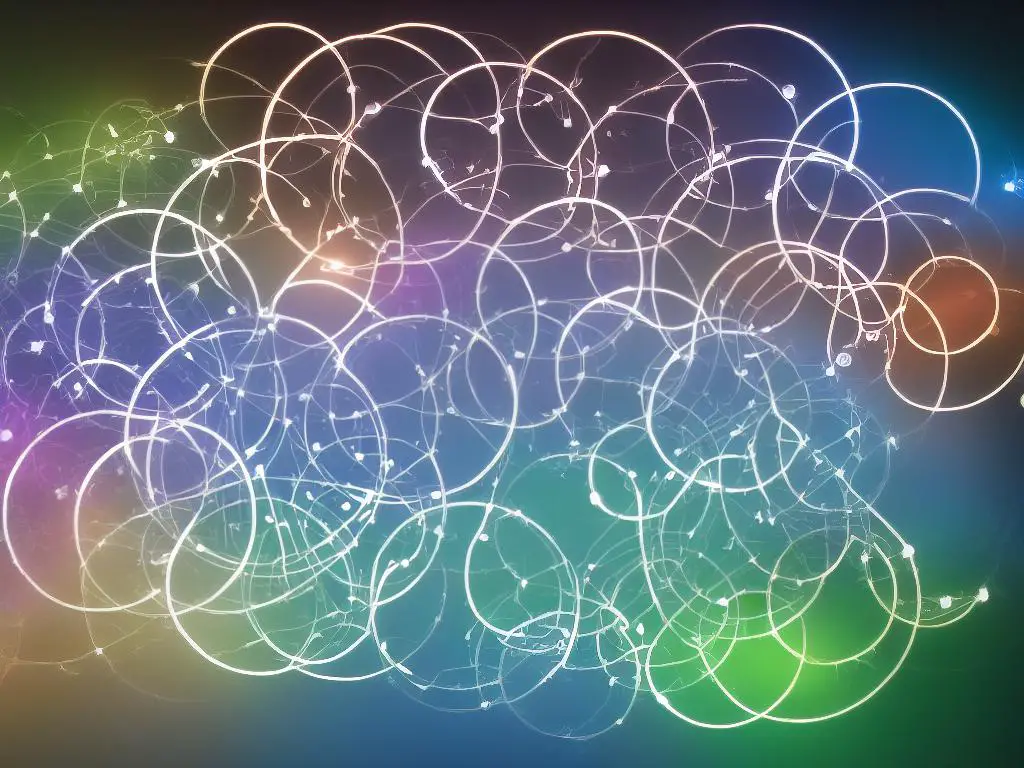Throughout history, shared dreaming has captivated the minds of people across countless cultures and spiritual belief systems. This enigmatic phenomenon has not only shaped intriguing mythologies, but it has also raised existential questions among philosophers, historians, and scientists alike. As diverse as our world may be, the notion of shared dreaming serves as a common thread that transcends cultural barriers, offering a unique perspective into our collective human consciousness.
History of Shared Dreaming
Shared dreaming, a phenomenon where two or more people experience the same dream, can be traced back to ancient civilizations and mythologies. In many indigenous cultures, dreams were considered a conduit to the spirit world and a means of communication between humans and supernatural entities. An intriguing aspect of these beliefs was the idea that individuals could share dreams or even enter one another’s dreams, in order to gain insight and knowledge.
One of the earliest known instances of shared dreaming comes from ancient Egypt. The Egyptians believed that their gods could visit them in their dreams, often to provide advice or warnings. Shared dreaming was considered a sacred act, as it allowed the dreamers to witness and experience these divine messages together. Ancient Greek dream temples, known as Asclepieions, were dedicated to the god of medicine, Asclepius, and patients seeking healing would sleep within the temple, hoping to receive a visitation from the god in their dreams. Some accounts detail instances where multiple patients claimed to have had the same dream about Asclepius, suggesting a belief in the possibility of shared dreaming.
In many Native American cultures, dream-sharing rituals were an essential aspect of their spiritual practices. Shamanic healers, or medicine men, were believed to possess the ability to enter another person’s dream to identify the source of illness or misfortune. These shared dream experiences were recounted to the community and served as a means of guidance and maintaining a connection with their ancestors and the spirit world. The Australian Aboriginal people also have a deep-rooted belief in shared dreaming, where the Dreamtime – a sacred era of creation and ancestral spirits – is actively shared amongst members of the community and passed down through generations.
Eastern spiritual traditions, such as Buddhism and Hinduism, have also explored the concept of shared dreaming through the yogic practice of Tibetan dream yoga and Hindu dream interpretation. In these traditions, spiritual practitioners devote their lives to mastering the art of lucid dreaming, which enables them to consciously enter and navigate their own dreams, as well as the dreams of others. The ultimate goal of these practices is the attainment of spiritual enlightenment, as well as using shared dreaming to hone their psychic and healing abilities.
The phenomenon of shared dreaming has captivated the interest of many across different cultures throughout history. These shared dreams, where two or more people experience the same dream, have sparked the imagination of countless individuals, leading to popular movies, books, and scientific research. Despite advancements in our understanding of the science of dreams, the notion of shared dreaming continues to fascinate and fuel our collective imagination.

Dream Theory and Interpretation
Sigmund Freud, an Austrian neurologist and founder of psychoanalysis, pioneered one of the first theories of dream interpretation that has influenced modern understanding of shared dreams. Freud believed that dreams serve as ‘the royal road to the unconscious,’ offering a glimpse into the inner workings of an individual’s mind. Within this context, shared dreaming can be seen as the manifestation of common unconscious desires and fears existing within a collective group. Freud theorized that dreams contain latent content, or the disguised manifestations of repressed thoughts and experiences, and manifest content, which is the literal depiction of these latent thoughts. Through the lens of Freud’s theory, the concept of shared dreaming can be understood as a reflection of the collective unconscious desires and fears shared by groups or cultures.
Carl Jung, a Swiss psychiatrist and psychoanalyst, took a different approach in his dream analysis. Unlike Freud, Jung viewed dreams as a means for the unconscious to communicate with the conscious mind, driving towards a process of individuation. Jung believed that shared dreams can be attributed to the concept of the collective unconscious, which encompasses shared ancestral experiences and archetypes. In contrast to Freud’s theory, which focused on individual desires and fears, Jung’s perspective of shared dreaming highlights the inherited psychic structures and themes that are universal across cultures.The cultural beliefs surrounding shared dreaming are diverse and span numerous traditions. For instance, in many indigenous cultures, shared dreaming is an integral aspect of their spiritual practices and a pathway for sacred guidance. Australian Aboriginals believe in the Dreamtime, in which ancestral spirits shape the landscape and bring forth life in an interconnected web of physical and spiritual dimensions. Similarly, among the Native American tribes, shared dreams are considered as avenues to communicate with spiritual guides and ancestors, leading to healing and wisdom.Furthermore, shared dreaming is often considered a potent tool for personal and spiritual growth in a variety of contemporary practices. The field of transpersonal psychology, for example, incorporates dreamwork and shared dreaming as a means to explore themes of human unity, spiritual growth, and self-discovery. Several modern dream interpretation techniques, such as dream incubation and group dreamwork, have been developed to foster an environment in which shared dreaming can be intentionally facilitated and cultivated.One notable phenomenon in the realm of shared dreaming is the occurrence of collective dream patterns and symbols that transcend cultural boundaries. Regardless of an individual’s background or culture, certain dream elements, such as being chased, falling, or encountering animals, are commonly experienced. The prevalence of these shared motifs suggests that although dreams are deeply personal experiences, there is an underlying commonality that unites a universal human psyche. Both Freud’s and Jung’s perspectives on dream interpretation acknowledge the concept of shared dreaming, which remains a captivating aspect of human experience, intriguing researchers and dream enthusiasts alike.

Shared Dreaming in Indigenous Cultures
Shared dreaming holds significant importance in the spiritual traditions and beliefs of many indigenous cultures across the globe. Native American tribes, for instance, view collective dream experiences as essential methods of gaining insight, healing, and guidance from their ancestors and spiritual realms. Tribes such as the Cherokee and Iroquois hold ceremonial dream circles in which members gather to share and interpret their dreams, believing that these dreams contain valuable wisdom for both individuals and the entire community. The connection between these cultural beliefs and the universal dream symbols discussed earlier highlights the fascinating interplay of personal and shared aspects of dreaming within the human experience.Similarly, in Aboriginal Australian culture, shared dreaming plays a vital role in connecting individuals to their ancestors, land, and spiritual beliefs. The concept of the Dreamtime, a transcendent reality where the past, present, and future coexist, is at the core of Aboriginal spirituality and culture. The Dreamtime stories are passed down through generations as shared dreams that encompass the creation myths, morality tales, and ancestral wisdom. By engaging in the act of sharing and interpreting these dreams, the Aboriginal people believe that they are maintaining their connection to their ancestors and the land, and preserving their culture.In various African spiritual traditions, shared dreaming is also an essential aspect of cultural beliefs. The Dogon people of Mali, for instance, rely heavily on the interpretation of dreams to understand the world and their place within it. They believe that ancestors can visit them in dreams to provide guidance and wisdom. Similarly, many tribes in South Africa practice a form of traditional healing called Sangoma, where shared dreams between the healer and their patient are considered vital to the healing process. The healer interprets the dreams and applies the guidance received from their ancestors for the benefit of the patient.In all these diverse cultures, the emphasis on shared dreams represents a broader belief in the interconnectedness of human experiences, the spiritual world, and the environment. These shared dreaming traditions serve to strengthen community bonds, pass down knowledge, and provide opportunities for individuals to grow and heal. Furthermore, they highlight the importance of listening to and understanding the wisdom of one’s ancestors, who are believed to remain a part of the cultural fabric long after they are gone.In conclusion, shared dreaming is a significant practice in various indigenous cultures, emphasizing the importance of spiritual interconnectedness and cultural preservation. By exploring the diverse beliefs of Native American, Aboriginal, and African communities, one can appreciate the profound significance of dreams in understanding the world, connecting with ancestors, and promoting individual and collective well-being. These shared dreaming practices not only bring individuals closer to their roots but also reinforce the importance of solidarity within a community, reminding us of the innate human need to connect with one another at a deeper level.

Religious and Spiritual Perspectives
In the Islamic belief system, dreams hold great importance, primarily because the Prophet Muhammad received his first revelation from Allah through a dream. In this context, shared dreaming is recognized as a visitation by a deceased person, a spiritual experience, or higher knowledge. Dreams are seen as messages from the divine and can provide insight and guidance. Muslims often believe in the idea of shared dreaming as a spiritual experience where two or more people may dream the same or similar dream, particularly when they share a deep connection or bond. This interconnectedness is seen as evidence of the Oneness of God, who is present in all things and connects everything, further demonstrating the importance of shared dreaming in various cultural beliefs.In Hinduism, the concept of shared dreaming can be linked to the idea of cosmic or collective consciousness. It is believed that all living beings have a connection to a single consciousness, known as the “Brahman.” This connection of interconnectedness extends to dreams, allowing for shared experiences between individuals. The Vedas, essential Hindu scriptures, explain a variety of dream phenomena, including sharing dreams with others, and the ability to connect with the deceased through dreaming. Dreams in Hinduism can also be viewed as a way to gain insights into one’s karma and spiritual development.Christianity, as a whole, does not have a universally established viewpoint on shared dreams. However, biblical accounts, such as the story of Joseph interpreting the dreams of others, offer some contextual support for the concept of shared dreaming. Additionally, many Christian mystics and saints through the ages have reported experiences of shared dreams and visions, which are often seen as gifts from the Holy Spirit or divine messages. In some Christian circles, sharing dreams is viewed as a means of spiritual connection, allowing experiences of divine communication to be accessible to multiple individuals.Buddhist teachings approach shared dreaming from a different angle. The Buddhist concept of interconnectedness and the idea of “dependent origination” implies that all things are connected, including dreams. Sharing dreams can be seen as a manifestation of the understanding that all phenomena arise through a dependent web of cause and effect. Tibetan Buddhism, in particular, delves deeply into the exploration of dreams, and includes practices like dream yoga. Lucid dreaming, an important aspect of dream yoga, is thought to offer insights into the nature of reality and the individual’s connection to the larger whole. Through these practices, it is possible for individuals to share dreams, adding levels of spiritual awareness and understanding to their waking lives.
Both shamanic and indigenous belief systems emphasize the importance of shared dreaming as a means for interconnected healing and receiving guidance from ancestral spirits. For these cultures, dreams are more than just personal experiences; they also serve as collective encounters that connect individuals to the broader community. The practice of sharing and interpreting dreams together is essential to their spiritual traditions, as it is believed to provide insights into the well-being and harmony of individuals and communities alike. Within these contexts, dream sharing often takes place during ceremonies, helping to solidify communal bonds and maintain balance with the natural and spiritual world.

Modern Shared Dreaming Phenomena
In contemporary society, shared dreaming has evolved to encompass a variety of forms and purposes beyond its roots in traditional cultural belief systems. One example of this progression is the rise of collective dream experiments, which involve groups of people engaging in coordinated sleeping and waking patterns in an effort to experience and document shared dreams. Through these experiments, both researchers and participants aim to uncover the underlying nature of dreams and explore the potential psychic connections that may exist between dreamers throughout the world.
Another area of shared dreaming that has expanded in recent times is its integration into therapeutic practices. Licensed therapists have utilized shared dreaming as a form of group therapy, allowing patients to progress in their healing by recounting their dreams with others who have experienced similar occurrences. Often referred to as “dream re-entry” or “group dream explorations,” participants may work with therapists to uncover subconscious thoughts or trauma, reflected through shared dreams, that may help address their various mental health concerns.
As the digital age continues to flourish, so do online communities dedicated to the exploration of shared dreaming. Internet forums, websites, and social media groups allow individuals from across the globe to communicate their dreams with one another, comparing experiences and searching for commonalities among their stories. Websites such as Reddit, Dreamviews, and the World Dream Bank facilitate these discussions, often hosting dream journals and providing resources on the topic of shared dreaming.
A notable case within the realm of online shared dream communities is the phenomenon known as “Tulpamancy.” Originating from Tibetan Buddhist practices, “Tulpas” are described as thought-forms or sentient beings created within a person’s mind, who can interact with their creators. Internet communities dedicated to tulpamancy have taken the concept further, fostering shared dream experiences where participants’ tulpas can engage with one another within the dream world. These communities often discuss techniques to achieve clarity and lucidity within shared dreams, allowing for greater interaction between tulpas and their human counterparts.
Shared dreaming, a phenomenon in which two or more people have the same or similar dreams, has long been a subject of fascination in various cultural beliefs. As science continues to explore the human mind and the neurological basis for dreaming, researchers are increasingly interested in whether this shared dreaming phenomenon holds any truth. In trying to understand the neurological basis of shared dreaming, scientists have looked at the connections between brain activity and dream content, as well as the ways in which people’s experiences and memories can shape their dreams.

Scientific Research on Shared Dreaming
Additionally, contemporary books and documentaries, such as ‘The D-Club’ by Michael Oliver and ‘The Oneironauticum’ by Jennifer Dumpert, delve into the modern phenomenon of shared dreaming. These works explore various instances of shared dreaming in the context of communal living, revealing intriguing findings on the interconnected nature of human consciousness and the power of dreams as a collective human experience. Overall, the modern exploration and expansion of shared dreaming both within and outside of cultural beliefs continue to push the boundaries of our understanding of human connection and the mysterious world of dreams.
One key argument in the scientific literature supporting shared dreams is the existence of similarities in dream content between people who are close or share common experiences. Previous research has shown that individuals who spend a significant amount of time together – such as family members or friends – might develop similar patterns of brain activity. This could potentially lead to parallel dream experiences. Furthermore, the study of mutual dreaming suggests a higher likelihood of occurrence in environments where individuals share close emotional and psychological bonds, which might influence their dream experiences.
In contrast, one of the main critiques against the existence of shared dreaming lies in the lack of tangible evidence. While people may report having the same or similar dreams, it is difficult for researchers to independently verify these claims. Most dream research relies on self-reported data, which can be highly subjective and prone to various biases. Additionally, people’s memories of their dreams can be unreliable, further complicating the process of validating shared dreaming experiences.
The debate surrounding the validity of shared dreams is further fueled by the lack of a unified theory of dreaming in scientific research. Currently, there are several competing hypotheses that attempt to explain the purpose and mechanisms of dreaming, such as the activation-synthesis hypothesis, cognitive theory, and threat simulation theory, among others. However, none of these theories specifically address the possibility of shared dreaming, leaving this phenomenon largely unexplained.
Intriguing both the public and scientific communities, the concept of shared dreaming is deeply rooted in cultural beliefs and warrants further exploration. While some researchers argue that neurological connections and close emotional bonds contribute to shared dreaming experiences, others counter that the lack of tangible evidence and a unified theory makes it difficult to validate the phenomenon’s existence. In order to better understand this captivating aspect of human consciousness and its ties to the cultural fabric that shapes our lives, more research is needed.

Photo by wocintechchat on Unsplash
Practices to Cultivate Shared Dreaming
The concept of shared dreaming has piqued interest across various cultural beliefs, with some even considering it an esoteric practice. A key method commonly stressed for cultivating shared dreaming experiences is maintaining a dream journal. This practice helps to develop dream recall, which is crucial when attempting to engage in shared dream exploration. By consistently logging dreams upon waking, the dreamer becomes more in tune with the subtleties and experiences that occur within the dream world. This ultimately facilitates the comparison and sharing of these experiences with others, contributing to a richer understanding of the shared dreaming phenomenon.
Lucid dreaming, in which the dreamer becomes aware that they are dreaming and can potentially control aspects of their dream, is another technique related to shared dreaming. Some cultures believe that when two or more individuals become lucid during a shared dream, it enables them to have direct communication and interaction within that dream space. Cultivating lucidity can be achieved through methods such as reality checks, affirmations, and specific practices like the WILD (Wake Induced Lucid Dream) technique. Developing lucidity can open the doors to shared dreaming possibilities, as individuals become more conscious and capable of navigating the dream world.
Maintaining healthy sleep habits is fundamental for optimal dream experiences and to engage in shared dreaming. Ensuring that one gets enough sleep each night and creating a sleep-conducive environment are essential factors in achieving quality dreams. It is important to establish a regular sleep schedule and limit exposure to electronic devices before sleep. In addition to these basic principles, some individuals choose to engage in specific rituals before bedtime to increase the likelihood of shared dream experiences, such as meditating on the intended person or scenario and creating a clear intention for the shared dream encounter.
Using devices like dream herbs or crystals has also been a part of various cultural beliefs surrounding shared dreaming. These cultures often emphasize the use of specific objects, such as mugwort or amethyst, known for their purported dream-enhancing properties. Incorporating these practices into one’s sleep routine may aid in the development of shared dreaming experiences. By experimenting with different methods, techniques, and tips, individuals interested in shared dreaming can determine what works best for them and potentially create the conditions necessary for this unique, cross-cultural phenomenon to occur.
Interestingly, as the concept of shared dreaming becomes popular in modern times, techniques like group intention setting and virtual dream-sharing forums have emerged. These practices involve individuals coming together to focus their intentions on a particular dream goal or location and then reconvening after their dream experience to discuss and compare their dream narratives. This approach emphasizes the power of collective thought and intention and may offer a contemporary means for individuals to explore shared dreaming in a digitally connected world.

Ultimately, the study and exploration of shared dreaming shed light on our profound need to connect with others and gain insight into the inner workings of our minds. By delving into such phenomena, from ancient cultural practices to modern scientific research, we encourage a deeper understanding of human experience and expand the horizons of our collective consciousness. As we continue to grow and evolve as a society, our fascination with shared dreaming remains a testament to our eternal quest for meaning and connection in this ever-expanding universe.
